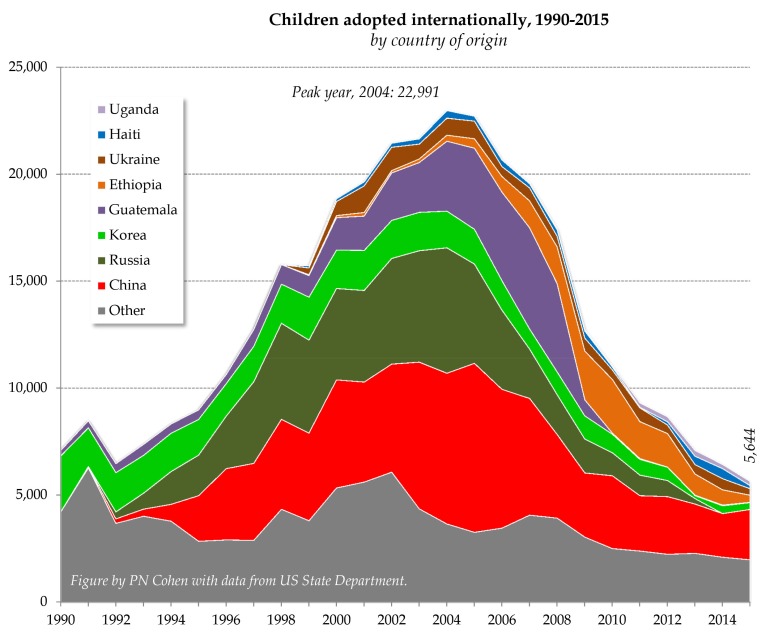Just updated my data series on international adoption. You can see previous posts, with commentary, at the adoption tag.
The data are the US State Department, which grants the adoption visas. It’s kind of a mess, back to 1999, here. (I have an old spreadsheet that goes back to 1990 for the big countries but I can’t find the link anymore.) The most recent report is here, and the briefer narrative is here. For the first time in those documents I saw an official description of what’s changed in China, which partly explains the broader trends. The State Department says 20,000-30,000 children are placed domestically in China now, as a result of increased government focus on domestic adoption, although without providing comparison numbers. They also say more than 90% of children adopted to the US from China now have special health needs, up from 5% in 2005. They conclude, reasonably it seems, that this results from “overall positive changes made to the child welfare system in China over the last decade.”
Anyway, here’s the chart. I show detail on those that ever had more than 2000 adoptions in one year, plus Haiti (because of the important history there), and Uganda and Ukraine (which are among the top five sending countries in the most recent year).


Thanks for this, Philip. Something you pointed out in your 2011 post, “Evangelicals, adoption, and adoption corruption,” is something I’m covering in my forthcoming book. Lots of critical media attention (related to work by Kathryn Joyce, whom you quote) hangs the boom-bust international adoption economy on evangelical Christians with an “adoption obsession.” Like you, I don’t see much evidence connecting the two. Especially when you consider adoption in general has been declining for the past 10 years. A recently-available collection of data on international, foster care, private agency, and other forms of adoption from can be found here: https://www.childwelfare.gov/pubPDFs/adopted0812.pdf
LikeLiked by 1 person
Interesting, thanks. I didn’t realize that domestic adoptions were declining as well. Two thoughts: 2008-2012 is the recession period, so that could explain the decline; and the intercountry adoptions are a declining percentage of the total, so they’re falling faster.
LikeLiked by 1 person
Good. Children without parents often have better lives living in local communities with other children and many different adults in their own culture. The children can, most of the time, avoid much problems this way. It also stops child trafficking.
LikeLike
greatt…
LikeLike
Here’s a source I drew on for lecture: http://www.asian-nation.org/adopted.shtml which does not have footnotes but does have a bibliography. The part that stands out to me is: “Studies tell us that for example, of the 265,524 orphan visas granted by the U.S. State Department between 1948-2000, 92,402 of them (34.8%) went to children from South Korea. Estimates suggest that anywhere between 110,000 – 150,000 Korean adoptees alone currently reside in the U.S., ranging in age from infancy to their 50s.” The estimated Korean-American population is about 1.5 million, so 7.3-10% of all Korean-Americans are adoptees.
LikeLiked by 1 person
As an adoptee, I am sure this is a good sign. And I just published a new anthology Stolen Generations: Survivors of the Indian Adoption Projects and 60s Scoop. We have lots of history to teach. https://splitfeathers.blogspot.com/
LikeLike